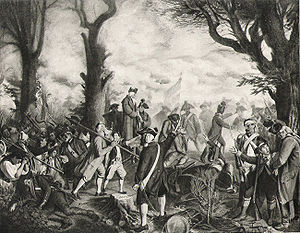Battle of Grauholz
| Battle of Grauholz | |||||||
|---|---|---|---|---|---|---|---|
| Part of French invasion of Switzerland | |||||||
 From The Battle of Grauholz, The last days of old Bern, painting by Friedrich Walthard |
|||||||
|
|||||||
| Belligerents | |||||||
|
|
|
||||||
| Commanders and leaders | |||||||
| Karl Ludwig von Erlach | Alexis Schauenburg | ||||||
| Strength | |||||||
| 6,400 | 18,000 | ||||||
| Casualties and losses | |||||||
| 700 | unknown | ||||||
The Battle of Grauholz on 5 March 1798 was a battle between a Bernese army under Karl Ludwig von Erlach against the French Revolutionary Army under Balthazar Alexis Henri Schauenburg. The battle took place at Grauholz, a wooded hill in what is now the municipalities of Urtenen-Schönbühl and Moosseedorf in the canton of Bern in Switzerland. The government of Bern had already surrendered the previous day and the Bernese defeat at Grauholz ended their resistance to the French in the north of the canton.
Attempting to gain control of key alpine passes and establish a buffer against the hostile monarchies of Europe, France first invaded some of the associates of the Swiss Confederation. Part of the bishopric of Basel was absorbed into France in 1793. In 1797 Napoleon annexed the Valtellina on the border with Graubünden into the new Cisalpine Republic in northern Italy and invaded the southern remainder of the bishopric of Basel.
In 1798, the confederacy was invaded by the French Revolutionary Army, at the invitation of the Republican faction in Vaud, led by Frédéric-César de La Harpe. Vaud was under Bernese control, but chafed under a government that often spoke a different language and came from a different culture. The ideals of the French Revolution had found a receptive audience in Vaud. So when Vaud revolted and declared a republic, the French had a pretext to invade the entire Confederation. The French army entered the Lemanic Republic on 24 January 1798 and Bernese troops retreated peacefully to Murten and Fribourg. French General Balthazar Alexis Henri Schauenburg deployed troops in two wings and prepared to attack from the north and south. Bern raised about 20,000 troops while the rest of the Confederation provided 4,100 support troops. The two wings of the French army had about 35,000 troops.
...
Wikipedia
